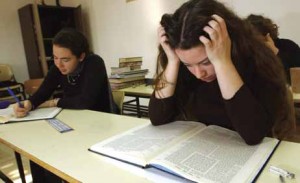Women and Torah Study
This article is excerpted from the larger article “Torah Perspectives on Women’s Issues” which appeared in the summer 1997 issue of Jewish Action.
“One who teaches his daughter [Oral] Torah — it is as though he teaches her frivolity.” 1
Rabbi Eliezer’s stunning, seminal ruling, apparently banning women from studying the Oral Torah, seemingly pre-empts any consideration of the issue. Upon closer inspection and reflection, however, two crucial distinctions emerge.
First of all, it is pure folly to imagine that the Mishna’s ban is all-encompassing or indiscriminate. The Shulchan Aruch confirms that women are clearly obligated to study halachot pertaining to mitzvot incumbent upon them.[2] Accordingly, teachers of Torah are not merely allowed to initiate and provide instruction in these areas; they are obligated to do so. The prohibition of teaching Oral Torah to women governs optional study; practical study is mandated.
This caveat has become especially repercussive for post-Enlightenment Jewry. Increasingly, instruction in Torah has become necessary not only to teach proper halachic observance, but also to inculcate enduring religious commitment and conviction. The saintly Chafetz Chayim, bestirred by this profound educational truth, wrote passionately and compellingly on the subject: “…presently…ancestral tradition has become exceptionally weak…surely it is a great mitzvah to teach [women] Chumash, Nevi’im and Ketuvim, and the ethical teachings of our sages such as Pirkei Avot, Menorat haMaor, and the like so that they will internalize our sacred faith because [if we do not adopt this educational course] they are prone to abandon the path of God.”[3]
Photo: Ariel Jerozolimski
The Chafetz Chayim’s innovation was educational, not halachic. He did not overturn the Mishna’s ban. Rather, as explained above, he recognized that it refers exclusively to optional instruction, whereas the instruction which he advocated was necessary. The subtlety and sophistication of the Chafetz Chayim’s analysis graphically illustrate that halachic decisions can only be rendered by outstanding halachic authorities. We clearly recognize that medical advice and treatment can only be responsibly offered by trained professionals. In complex cases we seek the foremost medical minds and experts. Their medical expertise is not subordinated to our uninformed, emotional reactions. Should our standards for halachic decision making be any less rigorous?
The Chafetz Chayim’s approach has universally prevailed. However, no such consensus exists concerning specifics of implementation. Rav Yosef Dov Soloveitchik zt”l, for example, assessing and responding to the challenges of girls’ education in his generation in Boston, advocated teaching Talmud to girls.[4] The wide diversity of opinion regarding the specifics of curricular implementation should not obscure the fundamental agreement regarding the underlying halachic-educational principle. Each of the different ideological strands of our polychromatic Orthodoxy poses unique educational challenges and demands individualized responses.[5] Indeed, educational policies and strategies which are uniform and impersonal are doomed to failure. A curriculum may be educationally sound and halachically valid in one venue, yet unsound and invalid in another. And thus the diversity of opinion regarding girls’ education is not only inevitable but vital; it mirrors the ideological diversity within Orthodoxy.
Let there be no misunderstanding. This latitude does not imply unbounded educational relativism or subjectivism. Nor does it automatically confer upon educators and rabbis the status of halachic authorities or decisors. On the contrary, it underscores the need for constant consultation with such authorities to ensure that all educational initiatives and enterprises are halachically sound.
The second distinction reflected in the Mishna’s phraseology is highlighted by Rabbi Yehoshua Falk (author of the Perisha)[6] who explains that the example of a father teaching his daughter Torah is designed to illustrate that instruction in optional portions of Torah may not be imposed upon women. Study which is not self-initiated is especially vulnerable to inadvertent distortion and frivolous trivialization. However, when women desire to voluntarily fulfill mitzvat Talmud Torah, their initiatives are welcomed and greatly rewarded. Accordingly, we must provide opportunities and forums for sincerely inspired women to study Torah.
Rabbi Mayer Twersky holds the Merkin chair in Talmud and Jewish Philosophy at the Rabbi Isaac Elchanan Theological Seminary.
1. B.T. Sota 20a.
2. Yoreh Deah 246:6.
3. Likutei Halachot, Vol. 2, Masechet Sota p.21.
4. I have attempted to provide proper perspective on this oft-cited, but rarely understood psak of the Rav zt”l in Tradition, Vol. 30 No.4.
5. Although the differences within Orthodoxy are significant, they are relatively minor. Whatever areas of discordance exist, they pale in comparision to the common commitment to HaShem, His Torah, Masorah, and the Jewish People, shared by all Orthodox Jews. If we all would internalize this simple proposition, much sinat chinam would be easily dispelled. In the words of the Psalmist [ch.119], “I am a friend of all those who fear You, and observe your statutes.”
6. Perisha Yoreh Deah 246 para. 15.

